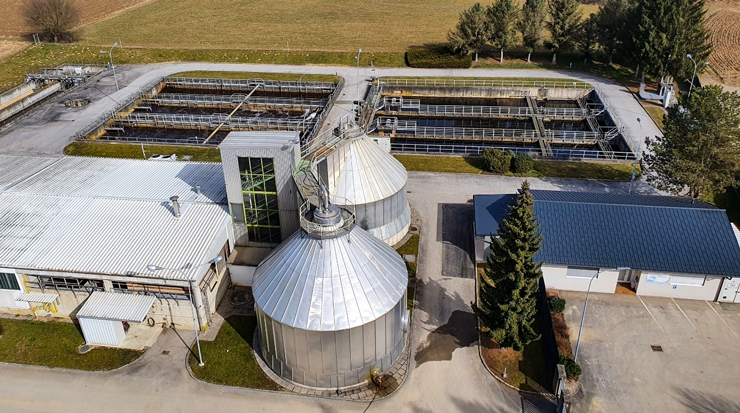The picturesque market town of Stainz in western Styria is not only known for its idyllic landscape and rich culture, but also for its responsible use of resources. In this context, the Stainz wastewater treatment plant recently implemented an optimization measure that significantly reduced flocculant consumption and increased the performance of the treatment plant.
Stainz: a place to live, discover and enjoy
The picturesque market town of Stainz, with around 9,000 inhabitants, blends harmoniously into the idyllic landscape of Western Styria. Its rural character and rich cultural history lend it a special charm. An outstanding landmark is the magnificent Stainz Castle, which is owned by the Meran family, descendants of Archduke Johann, who went down in history as the first mayor of the municipality.
Stainz is also known far beyond its borders for its Schilcher, a unique rosé wine made from the special Austrian red wine variety Blauer Wildbacher. This wine also characterizes the Schilcher Wine Route, which starts here and leads through the picturesque vineyards of the region.
Another highlight is the Stainzer Flascherlzug, a historic narrow-gauge railroad that once served as part of the Steiermärkische Landesbahnen and is now mainly used for tourist trips to show visitors the beauty of the West Styrian countryside. Not forgetting Stainzer Milch and the Messner meat factory, whose high-quality dairy products and sausages have established Stainz as a culinary insider tip.
Another highlight is the Stainzer Flascherlzug, a historic narrow-gauge railroad that once served as part of the Steiermärkische Landesbahnen and is now mainly used for tourist trips to show visitors the beauty of the West Styrian countryside. Not forgetting Stainzer Milch and the Messner meat factory, whose high-quality dairy products and sausages have established Stainz as a culinary insider tip.

Image 1: The baroque Stainz Castle in the middle of idyllic vineyards
The Stainz wastewater treatment plant
The
Stainz wastewater treatment plant has a capacity of 20,500 population equivalents (PE). The mechanical treatment comprises a 3 mm step screen, an aerated grit chamber, a primary clarifier and a biological treatment stage, consisting of three aeration tanks with 1,200 m² each and three secondary clarifiers with 720 m³ each. Iron III chloride Donau Klar classic from Donau Chemie Wassertechnik is used for phosphate elimination by means of simultaneous precipitation.
Sludge stabilization takes place via two 700 m² drop towers. The resulting digester gas (methane gas) of around 550 m³ per day is converted into electricity via a combined heat and power plant and contributes to 85% energy self-sufficiency. The sludge is dewatered using a screw press with a discharge capacity of 3.5 m³ per minute.

Abbildung 2: Kläranlage Stainz © Abwasserverband Raum Stainz
Wastewater treatment: Increased efficiency through polymer combination
Until now, the Stainz wastewater treatment plant has only used pure liquid polymer as a flocculant. It is used to bind fine suspended solids in the wastewater and form larger flocs, which can then be separated more easily. The addition of powder polymer improves the efficiency of solid-liquid separation during dewatering and leads to a better purification performance of the wastewater treatment plant.
In order to further increase the effectiveness of the clarification process, extensive polymer tests were carried out both in the laboratory and on the screw press. The experiments showed that the combined use of powder and liquid polymers leads to significant advantages:
- Polymer consumption was reduced by an impressive 33 % through this methodical adaptation.
- In addition, an improvement in processing quality was observed, which is reflected in a 1.5 % increase in the output dry mass.
The initial dry mass refers to the solids content in the sewage sludge after the dewatering phase. A higher initial dry mass is an indicator of more efficient dewatering, which in turn makes it easier to dispose of the sewage sludge.
For the sewage treatment plant, the changeover means an improvement in quality and a reduction in costs.
This optimization was successfully implemented in cooperation with the team at the Stainz wastewater treatment plant led by Peter Lienhart and Siegfried Wernig Donau Chemie Wassertechnik.
Conclusion: More efficient wastewater treatment thanks to polymer combination
The implementation of a combination of powder and liquid polymers at the Stainz wastewater treatment plant has led to significant improvements. Through extensive testing and analysis, polymer consumption has been reduced by a remarkable 33 %, while at the same time an increase in output dry mass of 1.5 % has been achieved. If you would like to know more about how we can help you with similar optimization projects, please contact us.
Visit our website to find out more about our
state-of-the-art water treatment products and their applications.
Read also:
Längenfeld wastewater treatment plant: Wastewater treatment with low acid capacity